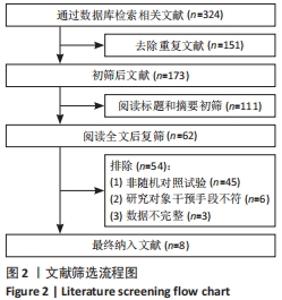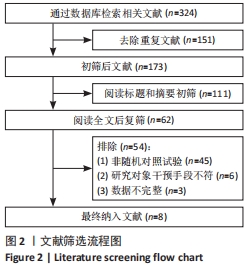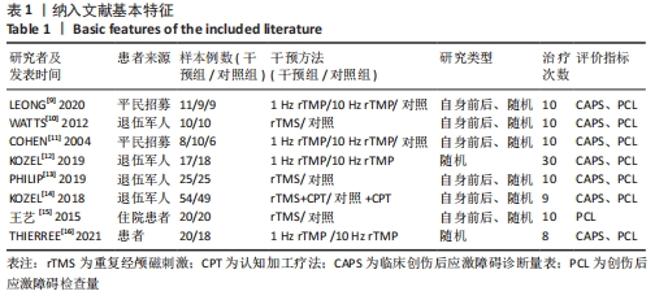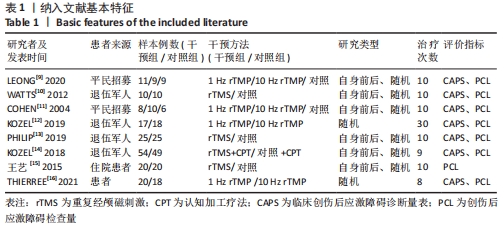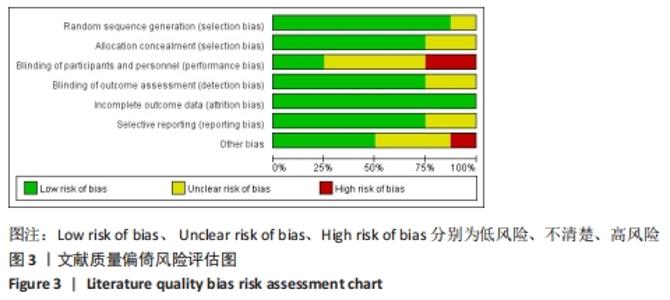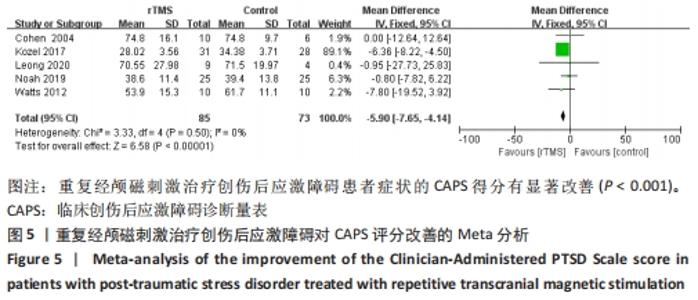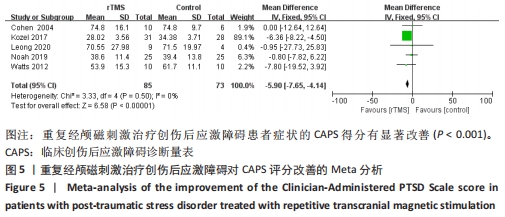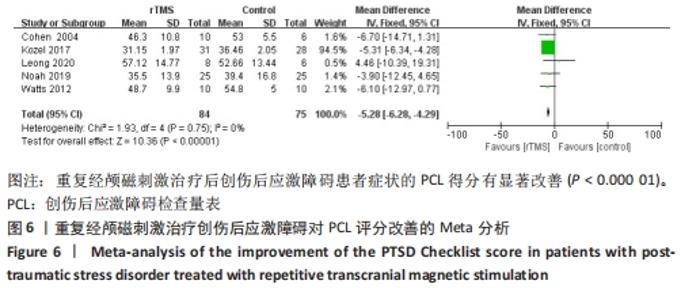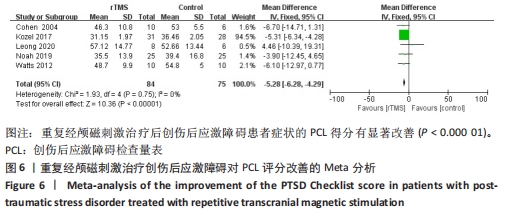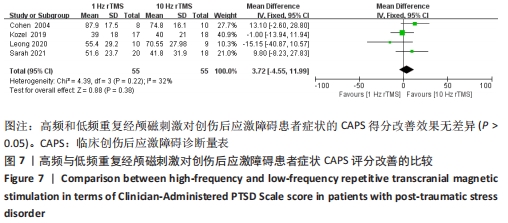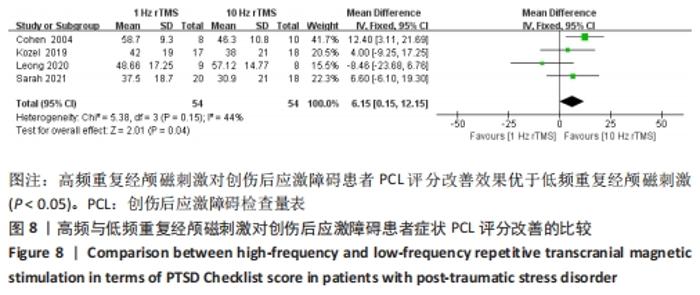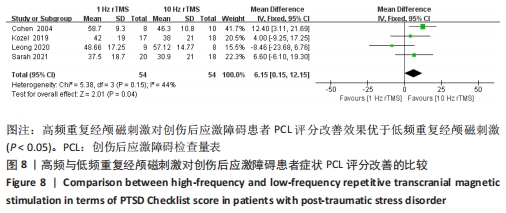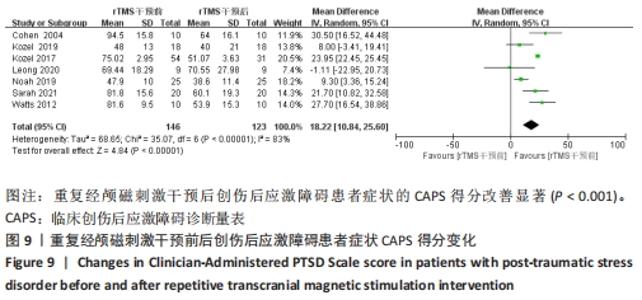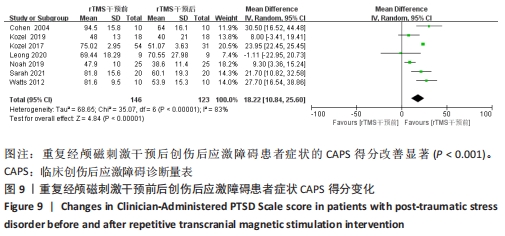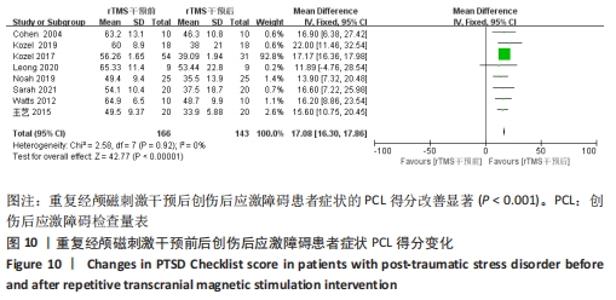Chinese Journal of Tissue Engineering Research ›› 2022, Vol. 26 ›› Issue (32): 5196-5200.doi: 10.12307/2022.935
Previous Articles Next Articles
A Meta-analysis of repetitive transcranial magnetic therapy in patients with post-traumatic stress disorder
Song Ge1, Liu Gang2, Jiang Liang2, Han Jiming1, Zhang Guiqing2
- 1Shihezi University, Shihezi 832000, Xinjiang Uygur Autonomous Region, China; 2First Affiliated Hospital of Shihezi University, Shihezi 832008, Xinjiang Uygur Autonomous Region, China
-
Received:2022-01-19Accepted:2022-02-25Online:2022-11-18Published:2022-05-14 -
Contact:Zhang Guiqing, MD, Professor, First Affiliated Hospital of Shihezi University, Shihezi 832008, Xinjiang Uygur Autonomous Region, China -
About author:Song Ge, Master candidate, Shihezi University, Shihezi 832000, Xinjiang Uygur Autonomous Region, China -
Supported by:the National Natural Science Foundation of China, No. 31860279 (to ZGQ)
CLC Number:
Cite this article
Song Ge, Liu Gang, Jiang Liang, Han Jiming, Zhang Guiqing. A Meta-analysis of repetitive transcranial magnetic therapy in patients with post-traumatic stress disorder[J]. Chinese Journal of Tissue Engineering Research, 2022, 26(32): 5196-5200.
share this article
Add to citation manager EndNote|Reference Manager|ProCite|BibTeX|RefWorks
| [1] American Psychiatric Association. Diagnostic and statistical manual of mental disorders. 5th ed. Arlington: American Psychiatric Publishing, 2013:271-272. [2] BENJET C, BROMET E, KARAM EG, et al. The epidemiology of traumatic event exposure worldwide: results from the World Mental Health Survey Consortium. Psychol Med. 2016;46(2):327-343. [3] KOENEN KC, RATANATHARATHORN A, NG L, et al. Posttraumatic stress disorder in the World Mental Health Surveys. Psychol Med. 2017;47:2260-2274. [4] HUANG Y, WANG Y, WANG H, et al. Prevalence of mental disorders in China: a cross-sectional epidemiological study. Lancet Psychiatry. 2019;6:211-224. [5] BERLIM MT, VAN DEN EYNDE F, TOVAR-PERDOMO S, et al. Response, remission and drop-out rates following high-frequency repetitive transcranial magnetic stimulation (rTMS) for treating major depression: a systematic review and meta-analysis of randomized, double-blind and sham-controlled trials. Psychol Med. 2014;44(2):225-239. [6] SLOTEMA CW, ALEMAN A, DASKALAKIS ZJ, et al. Meta-analysis of repetitive transcranial magnetic stimulation in the treatment of auditory verbal hallucinations: Update and effects after one month. Schizophr Res. 2012;142(1-3):40-45. [7] MCCANN UD, KIMBRELL TA, MORGAN CM, et al. Repetitive transcranial magnetic stimulation for posttraumatic stress disorder. Arch Gen Psychiatry. 1998;55(3):276-279. [8] LEFAUCHEUR JP, ALEMAN A, BAEKEN C , et al. Evidence-based guidelines on the therapeutic use of repetitive transcranial magnetic stimulation (rTMS): An update (2014–2018). Clin Neurophysiol. 2020;131(2):474-528. [9] LEONG K, CHAN P, ONG L, et al. A Randomized Sham-controlled Trial of 1-Hz and 10-Hz Repetitive Transcranial Magnetic Stimulation (rTMS) of the Right Dorsolateral Prefrontal Cortex in Civilian Post-traumatic Stress Disorder. Can J Psychiatry. 2020;65(11):770-778. [10] WATTS BV, LANDON B, GROFT A, et al. A sham controlled study of repetitive transcranial magnetic stimulation for posttraumatic stress disorder. Brain Stimul. 2012;5(1):38-43. [11] COHEN H, KAPLAN Z, KOTLER M, et al. Repetitive transcranial magnetic stimulation of the right dorsolateral prefrontal cortex in posttraumatic stress disorder: a double-blind, placebo-controlled study. Am J Psychiatry. 2004;161(3):515-524. [12] KOZEL FA, VAN TREES K, LARSON V, et al. One hertz versus ten hertz repetitive TMS treatment of PTSD: A randomized clinical trial. Psychiatry Res. 2019;273:153-162. [13] PHILIP NS, BARREDO J, AIKEN E, et al. Theta-Burst Transcranial Magnetic Stimulation for Posttraumatic Stress Disorder. Am J Psychiatry. 2019;176(11):939-948. [14] KOZEL FA, MOTES MA, DIDEHBANI N, et al. Repetitive TMS to augment cognitive processing therapy in combat veterans of recent conflicts with PTSD: A randomized clinical trial. J Affect Disord. 2018;229:506-514. [15] 王艺,彭李,周贤丽,等. rTMS对创伤后康复期PTSD患者核心症状、正负性情绪和心理弹性的影响[J].第三军医大学学报,2015,37(15):1571-1575. [16] THIERRÉE S, RAULIN-BRIOT M, LEGRAND M, et al. Combining Trauma Script Exposure With r TMS to Reduce Symptoms of Post-Traumatic Stress Disorder: Randomized Controlled Trial. Neuromodulation. 2021. doi: 10.1111/ner.13505. [17] MCGIRR A, FREDERIQUE V, TOVAR-PERDOMO S, et al. Effectiveness and acceptability of accelerated repetitive transcranial magnetic stimulation (rTMS) for treatment-resistant major depressive disorder: An open label trial. J Affect Disord. 2015;173:216-220. [18] PIGOT M, LOO C, SACHDEV P. Repetitive transcranial magnetic stimulation as treatment for anxiety disorders. Expert Rev Neurother. 2008; 8(10):1449-1455. [19] NARDONE R, SEBASTIANELLI L, VERSACE V, et al. Effects of repetitive transcranial magnetic stimulation in subjects with sleep disorders. Sleep Med. 2020;71:113-121. [20] 任萌,单春雷.重复性经颅磁刺激对脑卒中后抑郁的作用及其机制的研究进展[J].中华物理医学与康复杂志,2020,42(4):5. [21] 徐丹,田峻,陈晨,等.低频重复经颅磁刺激治疗脑卒中后失眠的疗效[J].中国神经免疫学和神经病学杂志,2021,28(1):4. [22] TAZOE T, PEREZ MA. Effects of Repetitive Transcranial Magnetic Stimulation on Recovery of Function After Spinal Cord Injury. Arch Phys Med Rehabil. 2015;96(4):145-155. [23] O’CONNELL NE, MARSTON L, SPENCER S, et al. Non-invasive brain stimulation techniques for chronic pain. Cochrane Database Syst Rev. 2018; 4(4):CD008208. [24] DAN JS, SEEDAT S, IVERSEN A, et al. Post-traumatic stress disorder: medicine and politics. Lancet. 2007;369(9556):139-144. [25] BRUNELLO N, DAVIDSON J, DEAHL M, et al. Posttraumatic stress disorder: diagnosis and epidemiology, comorbidity and social consequences, biology and treatment. Neuropsychobiology. 2001;43(3):150-162. [26] Ipser JC, Stein DJ. Evidence-based pharmacotherapy of post-traumatic stress disorder (PTSD). International Journal of Neuropsychopharmacology(6):825. [27] YAN T, XIE Q, ZHENG Z, et al. Different frequency repetitive transcranial magnetic stimulation (rTMS) for posttraumatic stress disorder (PTSD): A systematic review and meta-analysis. J Psychiatr Res. 2017;89:125-135. [28] GRISARU N, AMIR M, COHEN H, et al. Effect of transcranial magnetic stimulation in posttraumatic stress disorder: a preliminary study. Biol Psychiatry. 1998;44(1):52-55. [29] BERLIM MT, VAN DEN EYNDE F. Repetitive transcranial magnetic stimulation over the dorsolateral prefrontal cortex for treating posttraumatic stress disorder: an exploratory meta-analysis of randomized, double-blind and sham-controlled trials. Can J Psychiatry. 2014; 59(9):487-496. |
| [1] | Wang Yanjin, Zhou Yingjie, Chai Xubin, Zhuo Hanjie. Meta-analysis of the efficacy and safety of 3D printed porous titanium alloy fusion cage in anterior cervical discectomy and fusion [J]. Chinese Journal of Tissue Engineering Research, 2023, 27(9): 1434-1440. |
| [2] | Jiang Xiaocheng, Shi Lu, Wang Yinbin, Li Qiujiang, Xi Chuangzhen, Ma Zefeng, Cai Lijun. Systematical evaluation of bone fusion rate after interbody fusion in patients with osteoporosis and lumbar degenerative disease treated with teriparatide [J]. Chinese Journal of Tissue Engineering Research, 2023, 27(9): 1427-1433. |
| [3] | Li Wenjie, You Aijia, Zhou Junli, Fang Sujuan, Li Chun. Effects of different dressings in the treatment of burn wounds: a network meta-analysis [J]. Chinese Journal of Tissue Engineering Research, 2023, 27(7): 1141-1148. |
| [4] | Chen Guanting, Zhang Linqi, Li Qingru. Meta-analysis of the value of exosomal miRNA for the diagnosis of chronic kidney disease [J]. Chinese Journal of Tissue Engineering Research, 2023, 27(6): 970-976. |
| [5] | Yan Le, Zhang Huiping, Dai Lintong. Mesenchymal stem cells for allergic rhinitis: a meta-analysis based on animal experiments [J]. Chinese Journal of Tissue Engineering Research, 2023, 27(6): 977-984. |
| [6] | Feng Liang, Gong Shuhui, Huo Hongfeng. Effect of short-foot training on foot and ankle function in patients with flat feet: Meta-analysis and systematic review [J]. Chinese Journal of Tissue Engineering Research, 2023, 27(5): 799-804. |
| [7] | Pan Weimin, Wang Bing, Han Yabing, Li Ting, Song Jiaqi, Qin Huasheng, Liu Yang. Effects of blood flow restriction training on muscle strength, muscle mass and physical performance in older adults: a Meta-analysis [J]. Chinese Journal of Tissue Engineering Research, 2023, 27(5): 805-812. |
| [8] | Yu Jiaan, Liu Xinwei, Lian Hongyu, Liu Kexin, Li Zitao. Medial open-wedge tibial osteotomy versus lateral closed-wedge tibial osteotomy for unicompartmental knee osteoarthritis: a meta-analysis [J]. Chinese Journal of Tissue Engineering Research, 2023, 27(4): 632-639. |
| [9] | Xu Yangyang, He Peiliang, Meng Qingqi, Li Siming. A meta-analysis of the effects of continuous adductor canal block and continuous femoral nerve block on early activity after knee arthroplasty [J]. Chinese Journal of Tissue Engineering Research, 2023, 27(4): 640-645. |
| [10] | Chai Hao, Yang Deyong, Zhang Lei, Shu Li. 3D printing personalized osteotomy guide technology versus conventional total knee arthroplasty on the accuracy of lower limb force alignment: a meta-analysis [J]. Chinese Journal of Tissue Engineering Research, 2023, 27(4): 646-654. |
| [11] | You Aijia, Li Wenjie, Zhou Junli, Li Chun. Systematic evaluation of six dressings on wound safety following total hip and knee arthroplasty [J]. Chinese Journal of Tissue Engineering Research, 2023, 27(3): 486-492. |
| [12] | Ma Maoxiao, Cui Guofeng, Zhang Xue, Zhang Hong, Liu Youwen, Yue Chen. Complications after spinal fusion in patients with metabolic syndrome: a systematic review and meta-analysis [J]. Chinese Journal of Tissue Engineering Research, 2023, 27(22): 3602-3608. |
| [13] | Wu Yihan, Wei Qiaoye, Pang Yu, Liu Zhongqiang. Proprioception characteristics of functional ankle instability: a meta-analysis [J]. Chinese Journal of Tissue Engineering Research, 2023, 27(18): 2943-2952. |
| [14] | Peng Tuanhui, Yang Ling, Ding Xiaoge, Meng Pengjun. A systematic review and meta-analysis of the effects of long-term exercise on blood lipids in healthy elderly people [J]. Chinese Journal of Tissue Engineering Research, 2023, 27(14): 2276-2282. |
| [15] | Wang Ling, Chen Peng, Wang Guanglan, Zheng Cheng. Effects of kinesio taping on chronic ankle instability: a systematic review and Meta-analysis [J]. Chinese Journal of Tissue Engineering Research, 2023, 27(14): 2283-2290. |
| Viewed | ||||||
|
Full text |
|
|||||
|
Abstract |
|
|||||
